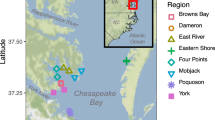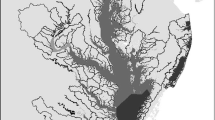Abstract
Intertidal habitats are only available to most nekton when inundated by tides. We assessed the variability of access to mangrove habitats for aquatic organisms over 3500 km of Australia’s east coast. After determining the elevation of the lower mangrove edge across 19 locations, we used 6 years of historic hourly tide gauge readings to estimate wetland edge flooding frequency, duration, and depth at each location. Although mangrove edges broadly tracked mean sea level along the east coast, deviations in edge elevation corresponded to substantial geographic variation in flooding dynamics. Mangrove edges were flooded from as little as 20% of the time in central Queensland sites, to as much as 90% of the time during some seasons in northern New South Wales. Flooding frequency and depth were also highly variable, with some mangrove edges flooding and draining almost twice as frequently as others. Flooding depth profiles revealed dynamic patterns of flooding of mangrove habitat. The variability in flooding dynamics demonstrates that the availability of mangrove habitat to aquatic organisms varies significantly among locations. This variability in flooding patterns suggests the nature of mangrove use and the functional value of these habitats for fishes and nektonic crustaceans may differ substantially among regions.







Similar content being viewed by others
References
Abrantes K. G., A. Barnett, T. R. Marwick & S. Bouillon, 2013. Importance of terrestrial subsidies for estuarine food webs in contrasting East African catchments. Ecosphere 4(1): Article ID 14.
Australian Bureau of Statistics, 2012. Year Book Australia. ABS Catalogue No. 1301.0. Australian Bureau of Statistics Canberra, Canberra.
Baker, R., B. Fry, L. P. Rozas & T. J. Minello, 2013. Hydrodynamic regulation of salt marsh contributions to aquatic food webs. Marine Ecology Progress Series 490: 37–52.
Ball, M. C., 1988. Ecophysiology of mangroves. Trees 2: 129–142.
Beck, M. W., K. L. Heck Jr, K. W. Able, D. L. Childers, D. B. Eggleston, B. M. Gillanders, B. Halpern, C. G. Hays, K. Hoshino, T. J. Minello, R. J. Orth, P. F. Sheridan & M. P. Weinstein, 2001. The identification, conservation, and management of estuarine and marine nurseries for fish and invertebrates. Bioscience 51: 633–641.
Chapman, V. J., 1960. Salt Marshes and Salt Deserts of the World. Interscience, New York.
Chen, Y. P. & Y. Ye, 2013. Growth and physiological responses of saplings of two mangrove species to intertidal elevation. Marine Ecology Progress Series 482: 107–118.
Clarke, P. J., 2014. Seeking global generality: a critique for mangrove modellers. Marine and Freshwater Research 65: 930–933.
Colmer, T. D. & T. J. Flowers, 2008. Flooding tolerance in halophytes. New Phytologist 179: 964–974.
Connolly, R. M., 1999. Saltmarsh as habitat for fish and nektonic crustaceans: challenges in sampling designs and methods. Australian Journal of Ecology 24: 422–430.
Crase, B., A. Kiedloff, P. A. Vesk, M. A. Burgman & B. Wintle, 2013. Hydroperiod is the main driver of spatial pattern of dominance in mangrove communities. Global Ecology and Biogeography 22: 806–817.
Curran, M., 1985. Gas movements in the roots of Avicennia marina (Forsk.) Vierh. Australian Journal of Plant Physiology 12: 97–108.
Duke, N. C., 2006. Australia’s Mangroves. The Authoritative Guide to Australia’s Mangrove Plants. University of Queensland, Brisbane.
Ellis, W. L. & S. S. Bell, 2008. Tidal influence on a fringing mangrove intertidal fish community as observed by in situ video recording: implications for studies of tidally migrating nekton. Marine Ecology Progress Series 370: 207–219.
Ennis, B. & M. S. Peterson, 2014. Nekton and macro-crustacean habitat use of Mississippi micro-tidal salt marsh landscapes. Estuaries and Coasts. doi:10.1007/s12237-014-9912-4.
Ennis, B., M. S. Peterson & T. P. Strange, 2014. Modeling of inundation characteristics of a microtidal saltmarsh, Grand Bay National Estuarine Research Reserve, Mississippi. Journal of Coastal Research 30: 635–646.
Faunce, C. H. & C. A. Layman, 2009. Sources of variation that affect perceived nursery function of mangroves, Ch. 11. In Nagelkerken, I. (ed.), Ecological Connectivity among Tropical Coastal Ecosystems. Springer, Dordrecht.
Faunce, C. H. & J. E. Serafy, 2006. Mangroves as fish habitat: 50 years of field studies. Marine Ecology Progress Series 318: 1–18.
Feller, I. C., C. E. Lovelock, U. Berger, K. L. McKee, S. B. Joye & M. C. Ball, 2010. Biocomplexity in mangrove ecosystems. Annual Review of Marine Science 2: 395–417.
Gibson, R. N., 2003. Go with the flow: tidal migration in marine animals. Hydrobiologia 503: 153–161.
Hammerschlag, N., M. Heithaus & J. Serafy, 2010. Influence of predation risk and food supply on nocturnal fish foraging distributions along a mangrove-seagrass ecotone. Marine Ecology Progress Series 414: 223–235.
ICSM, 2011. Australian Tides Manual, Version 4.1. Intergovernmental Committee on Surveying and Mapping Permanent Committee on Tides and Mean Sea Level. Commonwealth of Australia.
Igulu, M. M., I. Nagelkerken, M. Dorenbosch, M. G. G. Grol, A. R. Harborne, I. A. Kimirei, P. J. Mumby, A. D. Olds & Y. D. Mgaya, 2014. Mangrove habitat use by juvenile reef fish: meta-analysis reveals that tidal regime matters more than biogeographic region. PLoS One 9(12): e114715.
Kneib, R. T., 2000. Salt marsh ecoscapes and production transfers by estuarine nekton in the southeastern United States. In Weinstein, M. P. & D. A. Kreeger (eds), Concepts and Controversies in Tidal Marsh Ecology. Kluwer, Dordrecht.
Kneib, R. T. & S. L. Wanger, 1994. Nekton use of vegetated marsh habitats at different stages of tidal inundation. Marine Ecology Progress Series 106: 227–238.
Krauss, K. W., C. E. Lovelock, K. L. McKee, L. Lopez-Hoffman, S. M. L. Ewe & W. P. Sousa, 2008. Environmental drivers in mangrove establishment and early development: a review. Aquatic Botany 89: 105–127.
Lewis, R. R., 2005. Ecological engineering for successful management and restoration of mangrove forests. Ecological Engineering 24: 403–418.
Lewis, R. R., 2009. Methods and criteria for successful mangrove forest restoration, Ch. 28. In Perillo, G. M. E., E. Wolanski, D. R. Cahoon & M. M. Brinson (eds), Coastal Wetlands: An Integrated Ecosystem Approach. Elsevier, Amsterdam.
Lugendo, B. R., I. Nagelkerken, G. Kruitwagen, G. van der Velde & Y. D. Mgaya, 2007. Relative importance of mangroves as feeding habitats for fishes: a comparison between mangrove habitats with different settings. Bulletin of Marine Science 80: 497–512.
Meynecke, J. O., G. C. Poole, J. Werry & S. Y. Lee, 2008. Use of PIT tag and underwater video recording in assessing estuarine fish movement in a high intertidal mangrove and salt marsh creek. Estuarine Coastal and Shelf Science 79: 168–178.
Minello, T. J., K. W. Able, M. P. Weinstein & C. G. Hays, 2003. Salt marshes as nurseries for nekton: testing hypotheses on density, growth and survival through meta-analysis. Marine Ecology Progress Series 246: 39–59.
Minello, T. J., L. P. Rozas & R. Baker, 2012. Geographic variability in salt marsh flooding patterns may affect nursery value for fishery species. Estuaries and Coasts 35: 501–514.
Nagelkerken, I., S. J. M. Blaber, S. Bouillon, P. Green, M. Haywood, L. G. Kirton, J. O. Meynecke, J. Pawlick, H. M. Penrose, A. Sasekumar & P. J. Somerfield, 2008. The habitat function of mangroves for terrestrial and marine fauna: a review. Aquatic Botany 89: 155–185.
Rountree, R. A. & K. W. Able, 2007. Spatial and temporal habitat use patterns for salt marsh nekton: implications for ecological functions. Aquatic Ecology 41: 25–45.
Rozas, L. P., 1995. Hydroperiod and its influence on nekton use of the salt marsh: a pulsing ecosystem. Estuaries 18: 579–590.
Rozas, L. P. & M. W. LaSalle, 1990. A comparison of the diets of Gulf killifish, Fundulus grandis Baird and Girard, entering and leaving a Mississippi brackish marsh. Estuaries 13: 332–336.
Rozas, L. P. & R. J. Zimmerman, 2000. Small-scale patterns of nekton use among marsh and adjacent shallow nonvegetated areas of the Galveston Bay Estuary, Texas (USA). Marine Ecology Progress Series 193: 217–239.
Sasekumar, A., V. C. Chong, M. U. Leh & R. D’Cruz, 1992. Mangroves as a habitat for fish and prawns. Hydrobiologia 247: 195–207.
Schmitt, K., T. Albers, T. T. Pham & S. C. Dinh, 2013. Site-specific and integrated adaptation to climate change in the coastal mangrove zone of Soc Trang Province, Viet Nam. Journal of Coastal Conservation 17: 545–558.
Sheaves, M., 2005. Nature and consequences of biological connectivity in mangrove systems. Marine Ecology Progress Series 302: 293–305.
Sheaves, M., 2012. Ecosystem equivalence and the ability to generalise: insights from global consistencies in mangrove fish assemblages. Marine Ecology Progress Series 461: 137–149.
Sheaves, M., R. Baker, I. Nagelkerken & R. M. Connolly, 2015. True value of estuarine and coastal nurseries for fish: incorporating complexity and dynamics. Estuaries and Coasts 38: 401–414.
Sheridan, P. & C. Hays, 2003. Are mangroves nursery habitat for transient fishes and decapods. Wetlands 23: 449–458.
Staunton-Smith, J., J. B. Robins, D. G. Mayer, M. J. Sellin & I. A. Halliday, 2004. Does the quantity and timing of fresh water flowing into a dry tropical estuary affect year-class strength of barramundi (Lates calcarifer)? Marine and freshwater Research 55: 787–797.
Turner, R. E. & R. R. Lewis, 1997. Hydrologic restoration of coastal wetlands. Wetlands Ecology and Management 4: 65–72.
Ungar, I. A., 1991. Ecophysiology of vascular halophytes. CRC Press, Boca Raton.
Weinstein, M. P., S. Y. Litvin & J. M. Krebs, 2014. Restoration ecology: ecological fidelity, restoration metrics, and a systems perspective. Ecological Engineering 65: 71–87.
Youssef, T. & P. Saenger, 1998. Photosynthetic gas exchange and accumulation of pyhtotoxins in mangrove seedlings in response to soil physico-chemical characteristics associated with waterlogging. Tree Physiology 18: 317–324.
Acknowledgments
We thank Tom Minello and Lawrence Rozas for inspiring this work. This project arose during discussions between RB, MS, TM, and LR, during a visit to NOAA Fisheries by MS funded through an Australian Academy of Sciences Travel Fellowship. Tide gauge data for sites from Gladstone north were provided by Maritime Safety Queensland; for Brisbane by Port of Brisbane Pty Ltd; for all sites in New South Wales (Tweed Heads to Eden), data are owned by the Department of Environment, Climate change and Water, and collected and provided by Manly Hydraulics Laboratory, Department of Services, Technology and Administration, Manly Vale NSW; for Port Welshpool (Corner Inlet) by Gippsland Ports, and for Stony Point (Westernport Bay) by the National Tide Centre. RB is partially supported by a post-doctoral fellowship from the Tropical Landscapes Joint Venture between James Cook University and the Commonwealth Scientific and Industrial Research Organisation.
Author information
Authors and Affiliations
Corresponding author
Additional information
Handling editor: K.W. Krauss
Electronic supplementary material
Below is the link to the electronic supplementary material.
Rights and permissions
About this article
Cite this article
Baker, R., Sheaves, M. & Johnston, R. Geographic variation in mangrove flooding and accessibility for fishes and nektonic crustaceans. Hydrobiologia 762, 1–14 (2015). https://doi.org/10.1007/s10750-015-2329-7
Received:
Revised:
Accepted:
Published:
Issue Date:
DOI: https://doi.org/10.1007/s10750-015-2329-7




